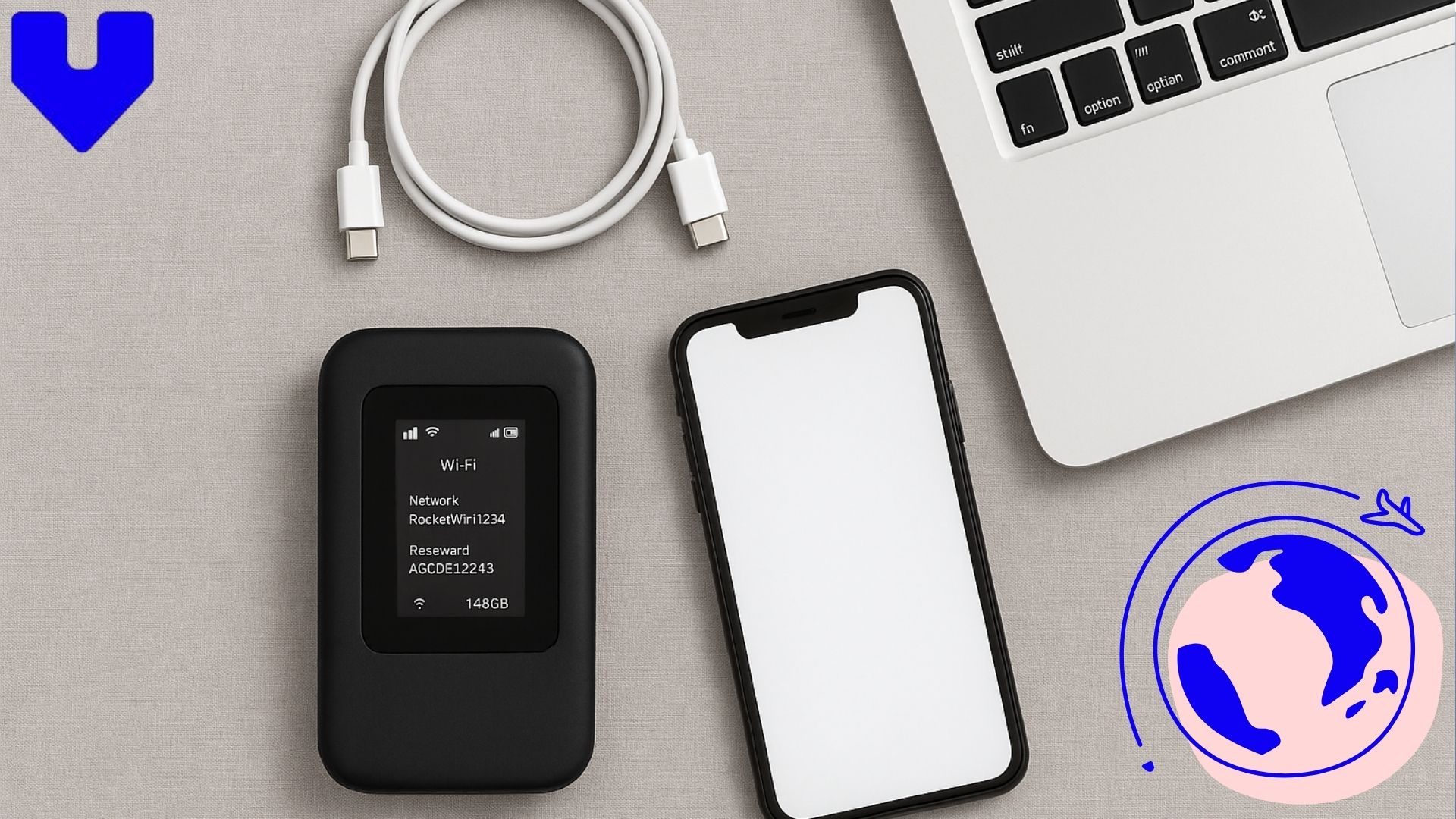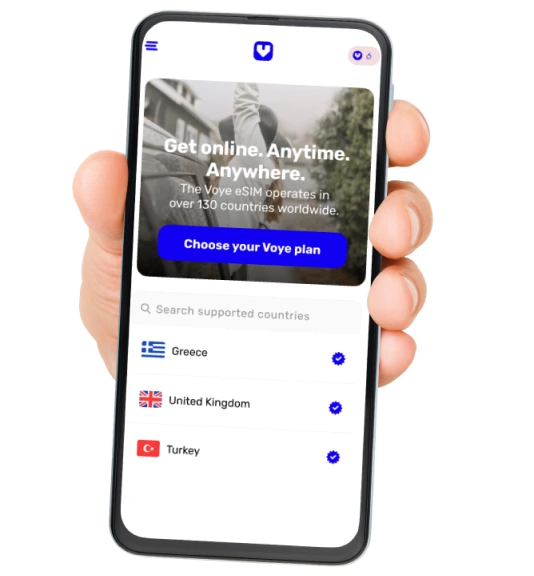Note that iPhone devices from Mainland China aren’t eSIM compatible. Also iPhone devices from Hong Kong and Macao aren’t compatible (except for iPhone 13 Mini, iPhone 12 Mini, iPhone SE 2020 and iPhone XS)
Staying connected while traveling has become just as essential as packing your passport. Whether you are navigating unfamiliar streets, booking transportation, sharing travel moments, or staying in touch with loved ones, mobile data is now a travel necessity. For many years, pocket Wi-Fi devices have been one of the most common solutions for travelers who want internet access abroad without relying on costly roaming.
However, with the rapid rise of eSIM technology, many travelers now wonder whether pocket Wi-Fi is still worth the cost and effort. Modern eSIM services offer cheaper, faster, and more effortless connectivity and they are now the preferred choice for most global travelers.
This guide explains everything you need to know about pocket Wi-Fi for travel including how it works, its advantages and disadvantages, hidden charges, when it is useful, and how it compares to digital alternatives such as the Voye Global eSIM which offers affordable global coverage in more than 160 countries.
By the end of this article you will be able to choose the best and most cost effective travel internet option for your specific needs.
What Is Pocket Wi-Fi?
Pocket Wi-Fi is a small portable device that connects to local mobile networks and broadcasts a personal Wi-Fi network for your phone, tablet, laptop, or any Wi-Fi enabled device. Many travelers also refer to it as a portable hotspot, travel Wi-Fi router, mobile Wi-Fi, or MiFi.
You can think of it as carrying a tiny router with you. Instead of inserting a SIM card into your smartphone or paying roaming fees to your home carrier, you activate the device and use its Wi-Fi signal. This was incredibly useful before eSIM technology because it allowed travelers to avoid high international charges.
Today pocket Wi-Fi is still used but mainly in specific scenarios. For most travelers, eSIMs have replaced the need to rent or carry a separate device.
How Pocket Wi-Fi Works
Pocket Wi-Fi is very simple. It contains a SIM card from a local or regional carrier. When you turn it on, it connects to the mobile network and then shares that connection with your personal devices through Wi-Fi.
Basic steps
- You rent or buy the device before your trip.
- The provider installs a SIM card inside the device.
- You turn it on and it creates a Wi-Fi network.
- You connect your devices using a password printed on the device.
- You return the device after your trip if you rented it.
Some companies allow you to buy the device and top up your data as needed, but rental services are far more common among short term travelers.
Advantages of Pocket Wi-Fi for Travelers
Pocket Wi-Fi became popular for several reasons and it still offers benefits that some travelers appreciate.
Connects Multiple Devices
Most pocket Wi-Fi devices allow between 5 and 15 devices to connect at once. This makes it useful for families, tour groups, or business teams traveling together. You can connect your phone, laptop, tablet, and any Wi-Fi accessory.
No Roaming Charges
Since the device uses a local SIM card, you avoid your mobile carrier’s international roaming fees which can be extremely expensive. Many travelers choose pocket Wi-Fi for this reason alone.
Works With All Device Types
Pocket Wi-Fi does not require your phone to be unlocked or eSIM compatible. Even very old phones or Wi-Fi only tablets can use the connection.
Simple Setup
The process is straightforward. Turn the device on, enter the password, and you are connected. No SIM card swapping or phone configuration is needed.
Stable Speeds in Strong Coverage Areas
In urban destinations with good network coverage, pocket Wi-Fi typically provides stable 4G or 5G speeds that are reliable for most travel activities.
Disadvantages of Pocket Wi-Fi
Despite its benefits, pocket Wi-Fi comes with several important drawbacks. Many travelers only learn about these issues after they have already rented a device.
You Must Carry an Extra Device
This is one of the biggest disadvantages. You must pack the device, charger, cable, accessories, and often a carrying case. It adds bulk and requires attention throughout your trip.
Battery Life Limitations
Most devices last between 8 and 12 hours. If you use the device heavily or travel through areas with weaker signal, the battery drains faster. When the battery dies, your internet connection ends immediately.
High Risk of Loss or Damage Charges
Pocket Wi-Fi providers usually charge between 50 and 300 dollars if you lose or damage the device. These penalties can cost more than the entire data plan of an eSIM.
Expensive Rental Costs
Pocket Wi-Fi rental fees add up quickly especially when including insurance, extra data, and shipping. In many cases an eSIM costs significantly less for the same or better coverage.
Requires Pickup and Return
Depending on the company you may need to pick up the device from the airport, wait at a counter, or organize delivery. At the end of your trip you must return it by hand or ship it back, often paying for shipping yourself.
Data Throttling
Even plans labeled as unlimited often slow your speed dramatically after you use a certain amount of high speed data.
Your Journey, Our eSIM
Stay online abroad with instant activation.
Typical Pricing and Hidden Costs
Pocket Wi-Fi pricing varies by company and country but here are common costs.
Rental Fees
- 5 to 15 dollars per day for unlimited 4G
- 10 to 20 dollars per day for 5G
Shipping Fees
10 to 30 dollars each way depending on distance and speed of delivery
Deposits
50 to 200 dollars which are refundable only if you return the device on time and in perfect condition
Loss and Damage Penalties
100 to 300 dollars
Additional Data Charges
Many plans limit the amount of high-speed data per day. If you exceed that limit you may need to purchase additional data.
When all fees are included, a week-long trip can easily cost 70 to 200 dollars or more which is significantly higher than most travel eSIM options.
Best Situations Where Pocket Wi-Fi Is Useful
Even with the convenience of eSIMs, there are still situations where pocket Wi-Fi makes sense.
Traveling in a Group
If four or more travelers want to share the same connection and stay close together, renting one pocket Wi-Fi device may be cost effective.
Using Wi-Fi Only Devices
Some tablets, cameras, or laptops do not support SIM cards or eSIMs. Pocket Wi-Fi provides connectivity for these devices.
Using an Older Smartphone
If your phone does not support eSIM or is locked to your home carrier, a pocket Wi-Fi device may be your best temporary solution.
Visiting Locations With Limited eSIM Coverage
Although rare today, some remote locations have fewer eSIM options. Pocket Wi-Fi might fill that gap depending on the provider.
Pocket Wi-Fi Compared With International Roaming
International roaming from your home carrier is usually the most expensive option. Many carriers charge daily roaming passes or high pay-as-you-go data rates. Data can cost more than 10 dollars per gigabyte in many cases.
Pocket Wi-Fi is often cheaper than carrier roaming but still more expensive than an eSIM or local SIM. Roaming also limits your ability to control data use and may include hidden fees.
Pocket Wi-Fi Compared With Local SIM Cards
Local SIM cards offer great value and can be very cheap in many countries. However, they come with limitations.
Advantages of Local SIM Cards
- Low cost
- Good local speeds
- Can be purchased almost everywhere
Disadvantages of Local SIM Cards
- Requires a physical SIM swap
- Phone must be unlocked
- Registration may require identification
- Not suitable for multi-country trips
- Topping up can be complicated in some destinations
Pocket Wi-Fi avoids SIM swapping but introduces cost and inconvenience. eSIMs remove both issues by allowing digital activation.
Pocket Wi-Fi Compared With eSIMs
eSIM technology has become the biggest reason for the decline of pocket Wi-Fi among travelers.
What is an eSIM?
An eSIM is a digital SIM card that is built into your phone. You activate it by scanning a QR code. It does not require a physical card, and you can install multiple eSIM profiles at once.
Key Advantages Over Pocket Wi-Fi
- No extra devices
- No charging
- No risk of loss
- Instant activation
- Lower costs
- Easier multi-country travel
- Better security
- No shipping or return required
With an eSIM, your phone connects directly to mobile networks. There is nothing to carry and nothing to manage.
Global Coverage, Local Rates
Experience hassle-free connectivity wherever you go.
Why eSIM Has Become the Most Popular Travel Internet Option
Travelers today prioritize convenience and affordability. eSIMs offer instant delivery, simple activation, and excellent global coverage. Because the technology is built into modern smartphones, you can install a plan within minutes and begin using it as soon as you arrive at your destination.
There is no device to pick up or return and no complicated rental procedures. This is why eSIMs have quickly become the preferred solution for solo travelers, digital nomads, and frequent flyers.
About Voye Global eSIM
Voye Global is a top telecommunications provider offering affordable travel data in more than 160 countries. Travelers can enjoy fast and reliable connectivity without physical SIM cards or pocket Wi-Fi devices. With experience previously focused on enterprise clients, Voye Global now delivers business-grade data services directly to consumers.
Why Travelers Choose Voye Global
- Instant activation with a QR code
- No hidden fees or contracts
- Global and regional options that fit any itinerary
- Affordable data rates
- High-quality network partners
- Secure and reliable connections
- Perfect for short trips, long trips or multi-country journeys
Voye Global eSIM gives travelers a modern solution designed for flexibility and simplicity.
Pocket Wi-Fi Compared With Voye Global eSIM
| Feature | Pocket Wi-Fi | Voye Global eSIM |
|---|---|---|
| Device Required | Yes | No |
| Battery Needed | Yes | No |
| Risk of Loss or Damage Fees | High | None |
| Setup | Physical pickup or shipment | Instant digital activation |
| Cost | High for most trips | Low |
| Multi Country Travel | Limited | Excellent |
| Security | Varies | High |
| Best For | Groups | Solo travelers or anyone who wants convenience |
How Voye Global eSIM Works
Using Voye Global eSIM is simple.
- Choose a country or regional plan.
- Buy a data package that fits your travel needs.
- Receive a QR code instantly by email.
- Scan the QR code to install the eSIM.
- Turn it on when you arrive at your destination.
There are no shipping delays and no returns. Everything is completely digital.
Who Should Still Consider Pocket Wi-Fi
Pocket Wi-Fi is not the best choice for most travelers today but it still has value in a few situations.
- Large groups that want to share a single data source
- Travelers with phones that do not support eSIM
- People carrying multiple high bandwidth devices such as cameras or laptops
- Travelers staying together in one place at all times
If you do not fall into these categories, an eSIM will usually deliver a better experience.
Final Recommendations
Pocket Wi-Fi can still be helpful but modern travel demands simplicity. For most people an eSIM is cheaper, easier, and more reliable. If your trip involves multiple countries, constant movement, or minimal luggage, pocket Wi-Fi becomes more of a burden than a benefit.
Choose Pocket Wi-Fi only if you are traveling in a group that wants to share one device or if your phone is not eSIM compatible.
Choose Voye Global eSIM if you want effortless, affordable, and fast mobile data coverage across the world without carrying extra equipment or dealing with rental procedures.
Most travelers today prefer the convenience and flexibility of Voye Global eSIM for a stress-free digital travel experience.

Seamless Mobile Data Everywhere
















